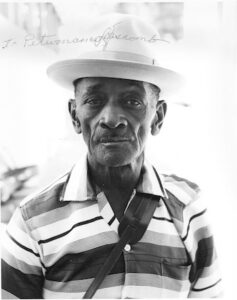
Mance Lipscomb
*Mance Lipscomb was born on this date in 1895. He was a Black blues singer, guitarist, and songster.
Beau De Glen "Mance" Lipscomb was from near Navasota, Texas. His father was a slave in Alabama; his mother was half African and Native American. As a youth, Lipscomb took the name Mance (short for emancipation) from a friend of his oldest brother, Charlie. His father left home as a child, so he had to leave school after the third grade to work in the fields alongside his mother.
For most of his life, Lipscomb supported himself as a tenant farmer in Texas. His mother bought him a guitar, and he taught himself to play by watching and listening. Lipscomb became a gifted performer then and played regularly for years at local gatherings, mainly what he called "Saturday night suppers" hosted by someone in the area. He and his wife hosted periodically such gatherings for a while. Until around 1960, most of his musical activity occurred around Navasota, Texas.
He was discovered and recorded in 1960 during a revival of interest in the country blues. He recorded many albums of blues, ragtime, Tin Pan Alley, and folk music, singing and accompanying himself on acoustic guitar. Lipscomb had a "dead-thumb" finger-picking guitar technique and an expressive voice. He honed his skills by playing in nearby Brenham, Texas, with a blind musician, Sam Rogers. His first release was the album Texas Songster (1960). Lipscomb performed songs in a wide range of genres, from old songs such as "Sugar Babe" (the first he ever learned) to pop numbers like "Shine On, Harvest Moon" and "It's a Long Way to Tipperary."
In 1961 he recorded the album Trouble in Mind, in 1963, he appeared at the first Monterey Folk Festival alongside other folk artists such as Bob Dylan. Unlike many of his contemporaries, Lipscomb had not recorded in the early blues era but recorded interviews in 1966 at his home in Navasota. These recordings are in the Ethnomusicology Library at the University of California, Los Angeles. Lipscomb became an important figure in the American folk music revival of the 1960s. He was a regular performer at folk festivals and folk-blues clubs around the United States, notably the Ash Grove in Los Angeles, California.
He was known for his singing, intricate guitar style, and being a storyteller and country "sage." Mance Lipscomb died in Navasota, Texas, on January 30, 1976, two years after suffering a stroke. He is buried in Oakland Cemetery, Navasota. His autobiography is I Say Me for a Parable: The Oral Autobiography of Mance Lipscomb, Texas Bluesman, narrated to Glen Alyn (published posthumously). He was the subject of a short 1971 documentary film called A Well Spent Life.